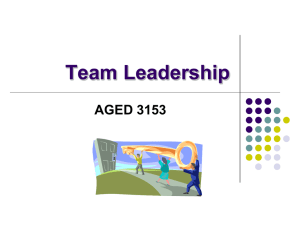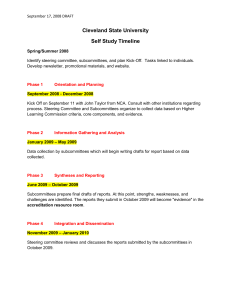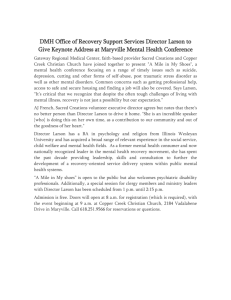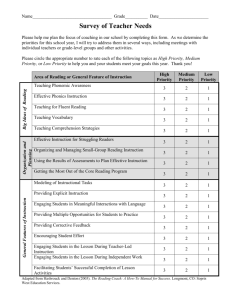Building Community through Accreditation: The Story of One IEP
advertisement
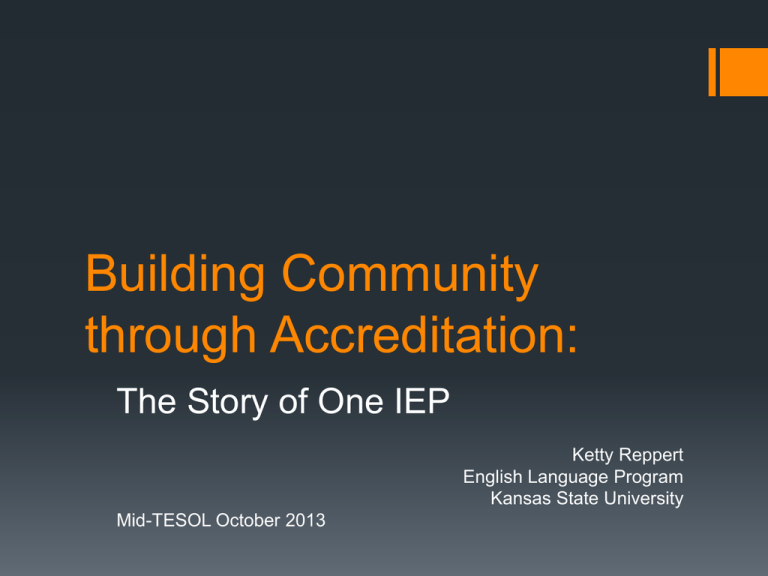
Building Community through Accreditation: The Story of One IEP Ketty Reppert English Language Program Kansas State University Mid-TESOL October 2013 The Story Begins… Students Enrollment Numbers Getting the Right Frame of Mind CEA Pre-TESOL Workshop CEA Pre-TESOL Workshop: Getting the right frame of mind The self-study should “[foster] a culture of continued improvement and [produce] positive change.” Teresa O’Donnell at CEA Pre-TESOL Workshop 2011 Organizational Tip: Color-code from the beginning Resources in different colors: Highlighters Page flags Sticky-notes Folders Organizational Tip: Color-code from the beginning Different colors for different areas of the program Curriculum/assessment Advising Administration Faculty Organizational Tip: Figure out how to mark (and track) your “to do’s” “star method” ( * ) sticky notes Bullet Journal other ideas...? Taking/making time to lay the groundwork Summer Interlude Summer Interlude: Taking/making time to lay the groundwork Lafasto and Larson’s Characteristics of Effective Leadership 1. 2. 3. 4. 5. 6. Focus on the goal. Ensure a collaborative climate. Build confidence. Demonstrate sufficient technical know-how. Set priorities. Manage performance. LaFasto and Larson, 2001 Summer Interlude: Taking/making time to lay the groundwork 1.Focus on the goal. Summer Interlude: Taking/making time to lay the groundwork “…almost any kind of strategic-planning process works better than none at all. Almost any kind of goal-setting process works better than none.” LaFasto and Larson, 2001 Our Goal is to: conduct a thorough, helpful, and accurate self-study based on the CEA Standards ensure that everyone in the ELP is involved document the process suggest and implement changes based on our findings write a clear and well-documented report that demonstrates how we meet the CEA Standards and demonstrate our fulfillment of the CEA Standards to the site review team so that the ELP will be granted 10-year re-accreditation, demonstrating that it is a valuable part of Kansas State University and is an excellent place for students to study and faculty and staff to work. Champoux’s Team Characteristics: ranked by importance 1. Commitment to a clear and common purpose (buy in) 2. Alignment of authority and accountability (act on defined roles and expectations) 3. High level of trust (rely on) 4. High level of respect (regard for) 5. Willingness to and ability to manage conflict (ask tough questions) 6. Focus on results (measure achievement/outcomes) Champoux, 2013 Champoux’s thoughts on “buy in” (The Goal) “It must be clear before it can be common.” Other aspects: A “higher order reason”/ purpose larger than self WIIFM (What’s in it for me) Room for Disagreement Champoux, 2013 Champoux’s thoughts on Authority and Accountability Know what we’re accountable for Why we’re accountable for it How to ask for accountability Have the authority we need Champoux, 2013 A final thought on teams and goals True teams “spring from two related sources”: “A mutual sense of purpose.” “Tangible goals based on that purpose.” Hill & Lineback, 2012 In the real world Making the most of the process Some of our “real world” issues Turnover in Associate Provosts Extremely rapid growth Funding for Admin support hasn’t kept up with rapid student and faculty expansion New things (e.g., Ecuador! TOEFL fraud! MA TEFL Degree! Afghanistan!) Other outside constraints (e.g., grad school policies, etc.) Making the Most of the Process: In the Real World “Most of the time, if the team isn’t working well, you’ll find something has been elevated above the team’s goal. It might be office politics. It might be individual agendas. It might be ego and control needs. It might be competing goals and priorities. Whatever it is, it’s draining the energy of the team away from the goal. And that’s a recipe for failure.” LaFasto and Larson, 2001 (emphasis added) Making the Most of the Process: In the Real World “Work backwards from goals to milestones to tasks” “Break down the work into smaller and smaller chunks until you have specific tasks that can be accomplished in a few hours or less.” Pozin, 2011 Making the Most of the Process: In the Real World 2.Ensure a collaborative climate. Making the Most of the Process: In the Real World One of my foundational assumptions: “Blaming does not help.… Everybody shares in the responsibility and that’s the truth.” Wheelan, 2005 Making the Most of the Process: In the Real World Identify (and acknowledge) the biggest challenges in your situation Focus on problem solving, rather than venting (LaFasto & Larson, 2001) Don’t delay Deal with them strategically prioritize Making the Most of the Process: In the Real World Get input from a variety of sources Identifying issues Working through them Can the challenges provide an opportunity? Demonstrating a real need to outside administration The chance to tackle something there’s never time for Rethinking “the way we’ve always done things” Problem solving that people can be engaged in Making the Most of the Process: In the Real World Be flexible If the plan/process isn’t working, try something else Don’t be afraid to change course mid-stream Be realistic When it’s OK to be “adequate” (which does not equal mediocrity) Meeting the Standards There is some latitude within the Standards for how we meet them. CEA accredits many different types of programs Beyond that, we have to do whatever we say that we do. If we use glowing terms of excellence, that’s what we have to show that we are. Mary’s mantra: We are adequate We are Adequate… But Consistently Aiming for Excellence We are good. We are striving for excellence. We only have to demonstrate to CEA that we are adequate . [We meet the standards and do whatever we say that we do.] We are not perfect (and never will be). Making the Most of the Process: In the Real World “Team problem solving is not harmony; it is the constructive integration of diverse perspectives.” LaFasto and Larson, 2001 Making the Most of the Process: In the Real World Don’t lose your sense of humor http://www.funnytimes.com/cartoons.php ?cotw_id=20100310#.UlRqPhCVqV1 Organizational Tip: Don’t throw too much away Keep in mind what you’ll need to have documented for the site visit/supporting documents Meeting notes Evidence of changes made Communication with faculty, students, etc. Getting the ball rolling Engaging Faculty and Staff Engaging Faculty and Staff: Getting the ball rolling Why? Accreditation is not a one-person job Thoroughness and accuracy Workload Site visit Engaging Faculty and Staff: Getting the ball rolling How? Communicate “Use every means at your disposal to ensure that goals and priorities are clear. Leave nothing to chance. Communicate repeatedly in a variety of media. And when you think you’re done, do it again.” LaFasto and Larson, 2001 Engaging Faculty and Staff: Getting the ball rolling Communication via: Email announcements Postings by copiers and printers Updates at faculty meetings Surveys asking for questions/feedback Subcommittee involvement Documents shared in secure online environment Informal face-to-face communication Open meetings/focus groups Engaging Faculty and Staff: Getting the ball rolling How? Less text is more Engaging Faculty and Staff: Getting the ball rolling How? Invite people Be realistic in terms of: Interest Time Engaging Faculty and Staff: Getting the ball rolling How? Listen Ask Address the hard questions Be realistic and communicate the bigger picture Tailoring it to your context Making the most of the process Making the most of the process: Tailoring it to your context Do the standards (or the stipulated process) address any areas of real weakness in your program? Where is there latitude in the standards or the process? Get several perspectives There’s probably more than one “right” way to do things Ask the accrediting agency Which other parts of the university/outside players could/should be involved? Making the most of the process: Tailoring it to your context 3.Build confidence. Making the most of the process: Tailoring it to your context “Clarity drives confidence. Confidence drives commitment.” LaFasto and Larson, 2001 Results Sheets Student Learning Outcome: A description of what the student will know or be able to do with the language as a result of the course of instruction. A student learning outcome is written in terms of observable and measurable language skills. Along with course objectives, student learning outcomes provide the foundation of assessment by inferring what will be assessed and appropriate methods of assessment. Course Objectives Specific curricular elements taught through course content and activities. The course objectives guide instruction in order to provide a learning experience for all students and, in aggregate, address the course goals. Course Goals The overall intended outcomes or targets for the courses. The goals guide the development of meaningful course objectives. Advancement and Placement SLOs Assessment Course Objectives Course Goals Mission Making the most of the process: Tailoring it to your context “Communicate repeatedly in a variety of media. And when you think you’re done, do it again.” LaFasto and Larson, 2001 Making the most of the process: Tailoring it to your context 4.Demonstrate sufficient technical know-how. Demonstrating sufficient technical know-how Depends on your situation, but should include: Familiarity with standards and accreditation process Facility in communicating Awareness of different aspects of the program/what’s going on A plan for managing documents and data produced by the accreditation process Confidence using the programs/systems your program uses If you don’t know, learn or find someone who does Organizational Tip: Have a plan for naming files before you get started Year_month_day_Standard# Double digits for month and day so computer will auto-sort into chronological order (2013_08_24_Standard 5) Decide if/how to utilize Headers Footers date/, file name/path, last revised by, etc. page #s Organizational Tip: Have a plan for storing/sharing files before you get started Shared/networked drive Secure online space Appropriate folder structure Including a way to tell what’s current Access for everyone who needs it Digital Records Naming and Management Resources Digital Records information from the State Archives of North Carolina http://www.ncdcr.gov/archives/ForGovernment/DigitalRecords.aspx Guidelines on File Naming Conventions for Digital Collections from the Digital Projects Advisory Group University Libraries (Colorado) http://ucblibraries.colorado.edu/systems/digitalinitiatives/docs/filenamegu idelines.pdf Naming Conventions for Electronic Documents from the Information Management Branch of the Government of Alberta https://www.rimp.gov.ab.ca/publications/pdf/DocumentNamingConventio ns.pdf For the long haul Engaging Faculty and Staff Engaging Faculty and Staff: For the long haul How? Get creative Goal of the week Trivial Pursuit ® Brainstorming race Virtual scavenger hunt for documents/policies Taboo ® Link checking “party” Engaging Faculty and Staff: For the long haul How? Recognize and utilize their expertise More than 20 volunteers read drafts of parts of the report Editing/proofreading Feedback Engaging Faculty and Staff: For the long haul How? Say “thank you” Update people on progress toward the goal CEA Self-Study: Track our Progress 2013 2012 2011 Year Activity Projected Date Form Steering Committee (SC) 25 April 2011 Appoint subcommittees and chairs and assign standards 25 April 2011 Present overview of process to faculty 28 April 2011 Initial Meeting of Steering Committee 2 May 2011 Submit Self-study plan 17 June 2011 Present overview of process to new faculty September 2011 First planning meetings of subcommittees 16 September 2011 Second planning meetings of subcommittees 30 September 2011 Work time and meetings for subcommittees and working groups (e.g. Curriculum Committees) October 2011February 2012 Progress report presentation at faculty meeting December 2011 Subcommittees submit supporting documents January-February 2012 Self-study coordinator sends first drafts of responses to sections A. and B. of all standards EXCEPT Curriculum, Length and Structure, and Student Achievement to Steering Committee for subcommittees to review February 2012 Self-study coordinator sends first drafts of responses to sections A. and B. of remaining standards for subcommittees to review March 2012 Open faculty meetings to review drafts and provide feedback April 2012 Subcommittees submit revisions of sections A. and B. and first drafts of section C. May 2012 General faculty/staff meeting to discuss recommendations May 2012 Subcommittees submit final revisions Summer 2012 Compilation of Final Self-study Report September 2012 Editorial Review October 2012 Submit Self-study report to CEA 1 November 2012 Site visit March 2013 CEA makes decision on Reaccreditation August 2013 Done! Organizational Tip: Charts and check-lists are your friends Organizational Tip: Charts and check-lists are your friends Along the way Lessons Learned Lessons Learned Along the way 5.Set priorities. 6.Manage performance. Setting priorities and managing performance Advantages of “leading from the periphery”: A different perspective or a “better view from the edge of the circle. Sometimes being farther away enables you to see things more clearly.” If you’re leading from the front, “it is almost impossible to see clearly what is happening behind your back.” Curtis, 2013 Setting priorities and managing performance Keep track of who needs to know what …and then tell them Make sure they know Check on completion/follow-up Setting priorities and managing performance Focus on creating the conditions for success rather than actively managing individual causal factors Site visit example “[H]ave the basic conditions established such that the natural course of events leads to the desired outcomes.” Hackman, 2002 Setting priorities and managing performance Organizational Tip: Approach meeting prep like class prep Be as prepared as you would before standing in front of a group of students Have clear objectives in mind Organizational Tip: Allow people to walk into meetings “guilt-free” Provide whatever handouts are needed for the meeting, even if you’ve already handed them out in the past Lessons Learned Along the way “…waiting is work…” Hackman, 2002 Lessons Learned Along the way “Any activity becomes creative when the doer cares about doing it right, or better.“ John Updike Lessons Learned Along the way “…there is always a choice. But it takes the courage of informed conviction, plus a good measure of willingness to innovate and experiment, to find ways to exercise that choice that can simultaneously harvest the diverse contributions of team members and foster efficient collective action.” Hackman, 2002 Organizational Tip: Back-up files early and often And in a secure location Organizational Tip: It’s not over till it’s over Be ready for last-minute tech disasters Did it work? “Well done is better than well said.” Ben Franklin How did we do? “a culture of continued improvement” Revised review cycles Currently undergoing “Program Review” Accreditation Program Student Services Assessment Curriculum How did we do? “positive change” Shared network clean-up and organization Website updating Re-organization and updating of Program Handbook Updated Student Handbook Revised process for handling student complaints Re-worked procedure for approving official policies Created Advisor Handbook Summer schedule increased to 18 hours Addressed end-of-summer placement problems as well as standards Extensive investment in better data management (integrated with University’s PeopleSoft system) How did we do? “10-year re-accreditation” “Life is a journey, not a destination.” References Champoux, T. (2013, March). Working together to create high performing teams: Making K-State 2025 work. Presentation at 17th Annual K-State Leadership Seminar, Manhattan, KS. Curtis, A. (2013, September 24). A gap in our field: leadership in language teaching. Retrieved from http://exclusive.multibriefs.com/content/a-gap-in-ourfield-leadership-in-language-education. Hackman, J. R. (2002). Leading teams: setting the stage for great performances. Boston: Harvard Business School Press. Hill, L. & Lineback, K. (2012, April 3). Good managers lead through a team. Retrieved from http://blogs.hbr.org/2012/04/good-managers-lead-through-a-t/. LaFasto, F. & Larson, C. (2001). When teams work best: 6,000 team members and leaders tell what it takes to succeed. Thousand Oaks, CA: Sage Publications, Inc. Pozin, I. (2011, December 13). 7 things highly productive people do. Retrieved from http://www.inc.com/ilya-pozin/7-things-highly-productivepeople-do.html. Wheelan, S. A. (2005). Creating effective teams: A guide for members and leaders. Thousand Oaks, CA: Sage Publications, Inc. Activities and Resources Brainstorming Race (http://adulted.about.com/od/icebreakers/qt/brainstormrace.htm) Bullet Journal (http:www.bulletjournal.com) Effectiveness Institute (http://www.effectivenessinstitute.com) Shelton, M. & Bauer, K. (1994). Secrets of highly effective meetings. Thousand Oaks, CA: Sage Publications, Inc. Silberman, M. & Clark, K. (1999). 101 ways to make meetings active: surefire ideas to engage your group. San Francisco: JosseyBass/Pfeiffer. Tropman, J. (2003). Making meetings work: achieving high quality group decisions. Thousand Oaks, CA: Sage Publications, Inc. What makes good collaboration? 10 Real World Tips (http://www.thoughtfarmer.com/blog/good-collaboration-10-tips/) Digital Records Naming and Management Resources Digital Records information from the State Archives of North Carolina http://www.ncdcr.gov/archives/ForGovernment/DigitalRecords.aspx Guidelines on File Naming Conventions for Digital Collections from the Digital Projects Advisory Group University Libraries (Colorado) http://ucblibraries.colorado.edu/systems/digitalinitiatives/docs/filenamegu idelines.pdf Naming Conventions for Electronic Documents from the Information Management Branch of the Government of Alberta https://www.rimp.gov.ab.ca/publications/pdf/DocumentNamingConventio ns.pdf Contact Information Ketty Reppert kreppert@ksu.edu A version of this presentation will be posted online: http://www.k-state.edu/elp/professional_presentations/ http://tinyurl.com/pfvxf9p
